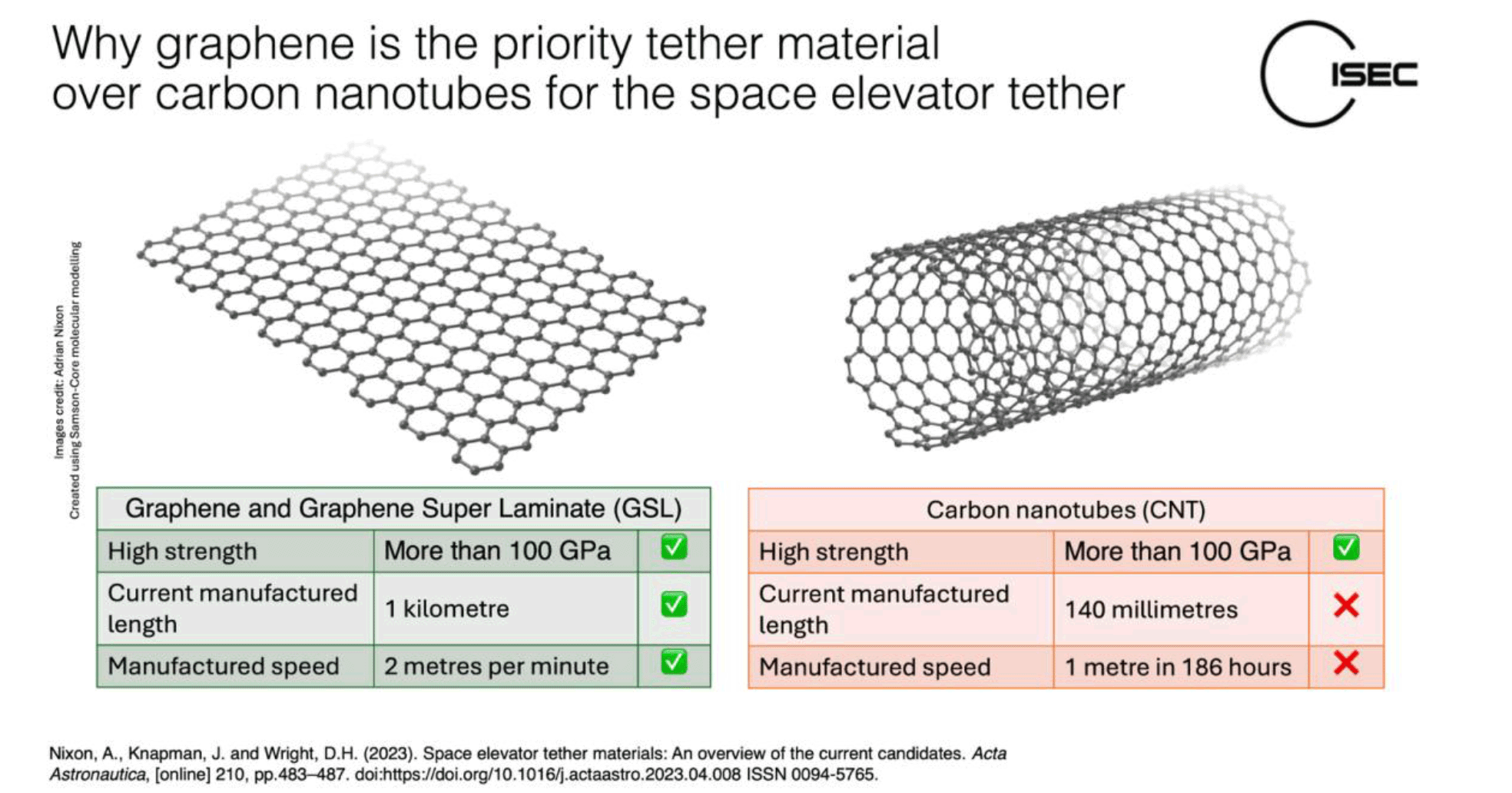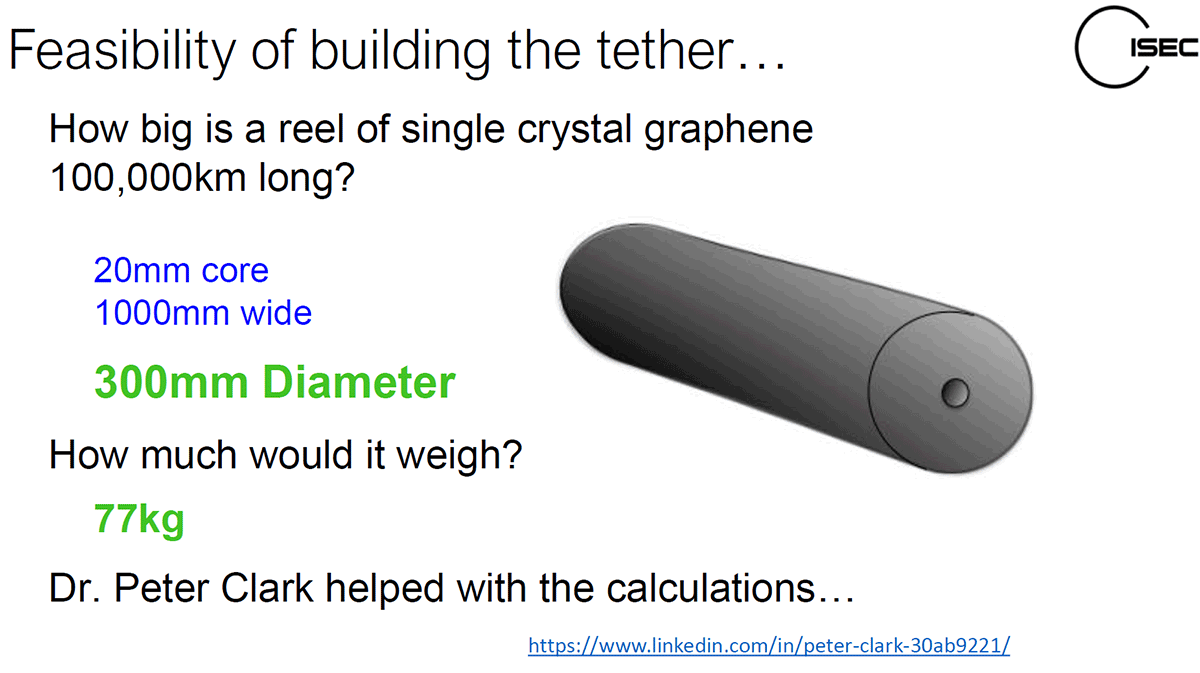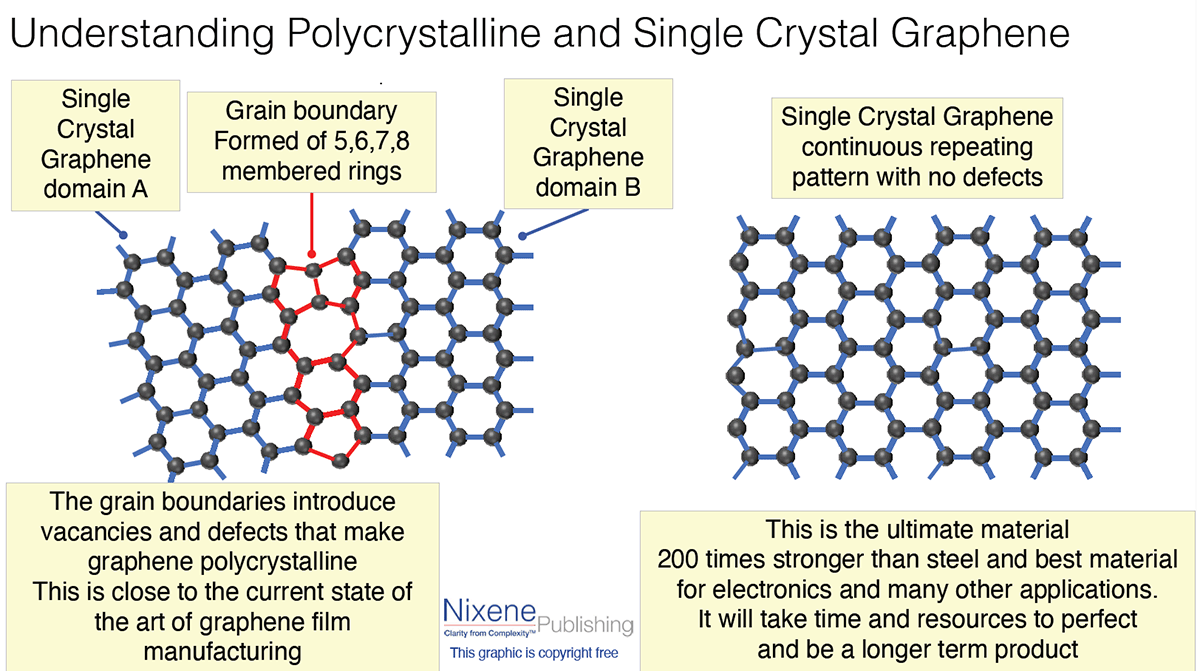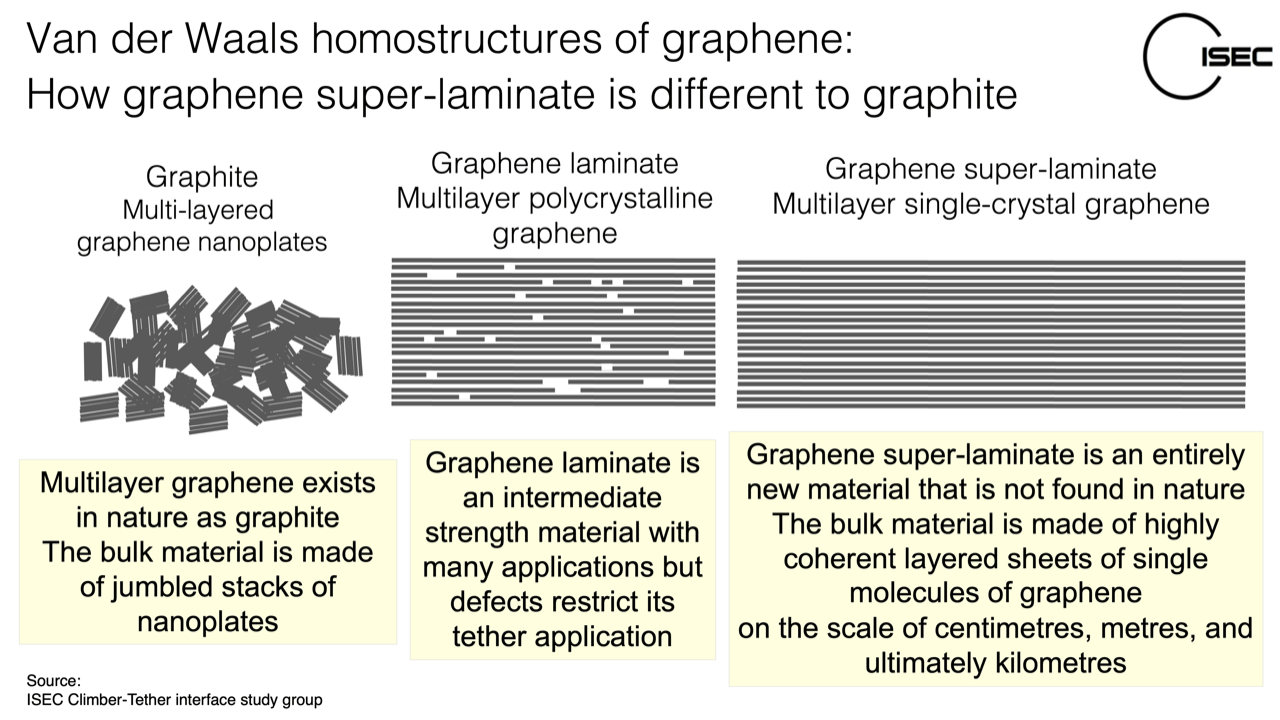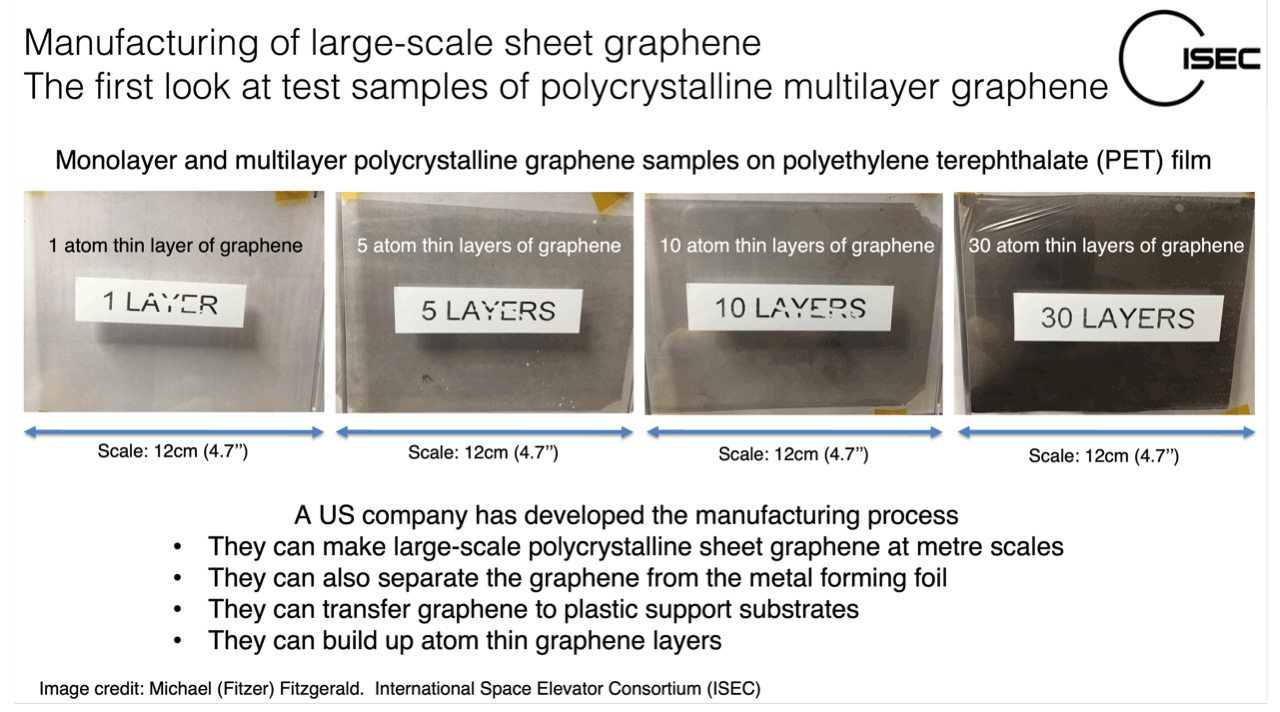Space Elevator Tether Materials:
The Crux of the Matter
Graphene Super Laminate is the Leading Tether Material of Choice!
“Space elevator tether production could begin in five to 10 years using Graphene as its material.” — “The Right Stuff”, an article in BIS Spaceflight (June 2023) by Adrian Nixon, John Knapman and Dennis Wright.
And the articles “The Right Stuff” in the British Interplanetary Society magazine SpaceFlight, June 2013, and “Building the Space Elevator Tether” in the Journal of the British Interplanetary Society, July 2023.
And the latest information on tether materials from the ISEC Newsletter.
The Space Elevator
The basic concept of a Space Elevator is to launch a satellite into geosynchronous orbit, lower a tether down to the surface of the Earth, and then climb up the tether into space. All of the parts of a Space Elevator can be done with today’s technology apart from one element – the tether, which requires a material strong and light enough to support its own weight plus that of the payload. The tether would be 100,000 kilometers long and 1 meter wide with the thickness of plastic wrap (e.g. Saran Wrap). Until recently the only candidate material was carbon nanotubes, but manufacturing this material in the quantities needed has proved a challenge unmet.
Three Tether Material Options
Today there are three known materials strong enough for a space elevator: carbon nanotubes, hexagonal boron nitride, and single crystal graphene. Single crystal graphene is currently the most promising. These three materials are illustrated in the diagram below.
Nobel prize winning discovery unlocks the potential of the Space Elevator
In 2010 two scientists at the University of Manchester, UK won the Nobel prize for discovering and isolating a new material called graphene. Graphene is a new form of carbon 200 times stronger than steel yet flexible and transparent. It is the world’s best conductor of heat and electricity. It has the highest melting point of any known material and is non-toxic. Graphene is strong enough and light enough to make the Space Elevator tether.
Forms of Graphene
There are three important forms of graphene: Graphene Powder, Single Crystal Graphene, and Polycrystalline Graphene. Single Crystal Graphene is the form that will ultimately manufacture the Space Elevator tether.
1. Graphene Powder
Graphene is starting to revolutionize manufacturing. It is currently made in powder form and the Ford Motor company is already making quieter, stronger cars in the USA. For example, the 2019 Ford Mustang was graphene enhanced. Graphene powder has been added to asphalt roads in Italy where it doubles the service life of the highway. However, graphene powder cannot be used to make the Space Elevator tether.
2. Single Crystal Graphene
Single crystal graphene is the term used to describe a large-scale sheet of graphene with no defects. Making this material as a single molecule of carbon at the macro scale was thought impossible until the Chinese made this in the laboratory in July 2017. Since then other laboratories in China, South Korea and the USA have made single crystal graphene, producing half meter long single crystals with tensile strengths that could support the Space Elevator.
3. Polycrystalline Graphene
Polycrystalline graphene is composed of single-crystalline grains of varying orientation joined by grain boundaries. Defects can also take the form of vacancies where one or more carbon atoms are missing.
Industrial Manufacturing of Graphene
To make the material for the Space Elevator tether requires manufacturing on very large scales and speeds. Carbon nanotubes can currently be made at sub-meter lengths, very slowly. If a nanotube could be made a meter long, it would take 11 days. Graphene on the other hand, in its polycrystalline form, can already be made at lengths of one kilometer and a speed of 2 meters per minute. Neither material can be made at tether quality yet, but the trajectory clearly favors graphene as the industrial material of choice. There are at least four competing industrial companies manufacturing graphene at present.
Graphene Laminate
When graphene layers are formed without contaminants present each atomic layer can engage with the others. An electrostatic attraction called the Van der Waals force helps bond the layers together, creating a much stronger structure than would otherwise be expected. This bonding strength increases the rigidity with the cube of the number of layers. Also, a Van der Waals homostructure of single crystal graphene will be much stronger than one made from polycrystalline graphene.
In 2021 a U.S. company supplied ISEC with samples of layered polycrystalline graphene ranging from one atom thick to 30 atoms thick. A Space Elevator tether would be about 12,000 atoms thick at its thickest point.
Graphene Layer Bonding
The Van der Waals bond between the layers is much weaker than the covalent bond between the atoms within each layer. The ISEC climber-tether interface study group discovered that the Van der Waals bond between layers of graphene super-laminate is about 35 times too weak to support a 20-tonne climber without causing slippage between the layers.
A potential solution has been found in the literature. When two such layers are pressed together with sufficient force it can create a stronger bond called an sp3 hybrid bond, which is like that found in diamond which accounts for the diamond’s great strength. Using pressure to create such cross-links between the layers would in effect "spot weld" the tether and improve its resistance to slipping under shear. This bonding between layers is shown in the graphic below.
Given that industrial processes rarely produce perfect materials, can imperfect graphene be made good enough to do the job of a tether material?
Work shows that provided the material has crystal grain boundaries that are “well-stitched” and have few defects, current manufacturing methods can make graphene that is strong enough to make a space elevator tether.
The Elon Musk Challenge
Elon Musk, well known for cutting to the chase, had this to say in a tweet about Space Elevators in 2015:
This was written before single crystal graphene was developed in the laboratory, and we assume he would accept a suitably strong graphene structure longer than a footbridge as well. The longest footbridge in the world is Sky Bridge in the Czech Republic which opened in May 2022 and is 721 meters in length. A photo is below.
Photo by Tomas Drapal, presented here and modified (cropped) under its Creative Commons license.
Polycrystalline graphene has already exceeded that length. We anticipate the day when this is matched by single crystal graphene (or “well-stitched” polycrystalline graphene of sufficient strength), and we plan to have a good conversation with Mr. Musk at that time. We have a small pool on when that might occur.
Latest information about Tether Materials from the ISEC Newsletter
All articles also available in a single PDF file.
Spot Welding Layers of Graphene Can Now Be Done - and it Makes Superdiamond (September 2025)
Continuous Manufacturing of CVD Graphene Around the World (August 2025)
Could a Tether Made from Multilayered Hexagonal Boron Nitride be Cross-linked to Spot-weld the Layers? (July 2025)
The Space Elevator Tether and Space Debris: Irresistible Force Meets Impenetrable Object? (June 2025)
How Isotopes of Carbon Would Affect a Tether Made from Graphene Super Laminate (May 2025)
A Tether Made from Graphene Becomes Tougher with More Layers (April 2025)
How the Edges of Graphene Affect the Tensile Strength (March 2025)
A Closer Look at Carbon Fibre as a Candidate Tether Material (February 2025)
How Water Affects the Friction Behaviour of Graphene (December 2024)
Making Graphene from Molten Metal (November 2024)
A Prediction: Graphene Will be Found on the Planet Mercury (October 2024)
Graphene is One Atom Thin, So Why is it More Than Twice the Thickness of a Carbon Atom? September 2024)
Using artificial intelligence (AI) to calculate how big would be a reel of one layer of space elevator tether material (August 2024)
Up Close and Personal With the Space Elevator Tether (July 2024)
How Could We Use This Property of Graphene Super Laminate? (June 2024)
Repairing a Graphene Space Elevator Tether (May 2024)
How Strong Must a Graphene Tether Material Be? (April 2024)
Imperfect May Be Good Enough for Graphene Tether Materials (March 2024)
How Radiation from the Sun Could Affect a Space Elevator Tether (February 2024)
Could a Space Elevator Tether Burn? (December 2023)
How 2D Material Laminates Respond to Temperature Changes (November 2023)
Electrical Conductivity in Graphene Laminates (October 2023)
Tether Materials Enabling Ultra-high Buildings (September 2023)
How Ionising Radiation Affects Graphene Super Laminate (August 2023)
Engaging with the Space Industry and General Public in the UK (July 2023)
A Graphene Super Laminate Tether May Be More Resilient to Heating than We Thought (June 2023)
How Tether Materials’ Tensile Strength Responds to Temperature (May 2023)
How Tether Materials Resist Tearing (April 2023)
Sliding of Layers in Graphene Super Laminate (March 2023)
Measuring the Friction of Graphene Super Laminate (February 2023)
International Standards Organisation Standards for Large-area Sheet Graphene (December 2022)
Snowflake Graphene (November 2022)
Borophene (October 2022)
Thinking about How to Prevent Slipping in a Layered Tether (September 2022)
Graphene Super-laminate (August 2022)
A New Two-dimensional Material: Graphyne (July 2022)
Carbon Nanotube / Graphene Yarn (June 2022)
How Edge Defects Affect the Tensile Strength of Monolayer Graphene (May 2022)
Carbon Nanotubes and Graphene: Part 2: How We Can Know What We-Know-We-Don’t-Know (April 2022)
Carbon Nanotubes and Graphene (March 2022)
Quality Control for Large-area Sheet Graphene (February 2022)
Tether-Climber Interface (December 2021)
ISEC Visits the Graphene Engineering Innovation Centre (November 2021)
Industrially Manufactured, Multi-layered, Large-area, Freestanding Sheet Graphene (October 2021)
Graphene Manufacturing and Costs Trends (September 2021)
Latest Developments in Manufacturing Graphene (August 2021)
Fracture Resistance in 2D Materials (July 2021)
What Would the Tether Look Like? Part 3: More Evidence from a Graphene Heat Spreader (June 2021)
Space Elevators on Other Planets (May 2021)
Industrially Manufactured Multi-layered Large-scale Sheet Graphene Samples are Sent to ISEC for Testing (April 2021)
What Would the Tether Look Like? Part 2: A Tale of Two Tethers (March 2021)
What Would a Tether Made from 2D Materials Look Like? (December 2020)
The Graphene Engineering Innovation Centre (March 2020)
News from the Graphene Engineering Innovation Centre (February 2020)


